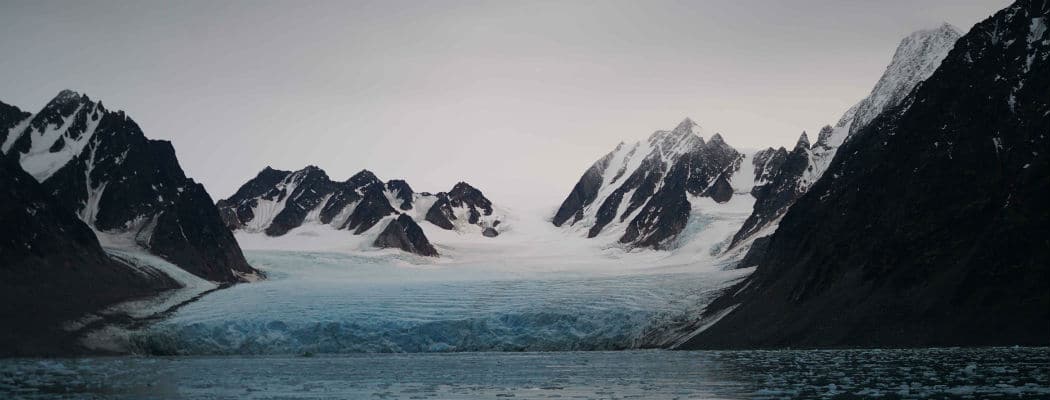Brooklyn-based fine art photographer and artist Leigh McCarthy — who features Nantucket prominently in her work and considers the island her second home — recently took her talents (and her camera) aboard a Norwegian tall ship and set sail through the Arctic. Departing from Longyearbyen, Svalbard, she spent two weeks exploring glaciers, a former whaling station, and an abandoned Russian mining town. We caught up with McCarthy to learn more about how Nantucket’s wild beauty keeps her inspired, what prompted her to embark on her Arctic adventure, and where her travel bucket list will take her next.
 N MAGAZINE: Tell us a little about your connection to Nantucket.
N MAGAZINE: Tell us a little about your connection to Nantucket.
MCCARTHY: My connection goes way back to before I was born. My Mom worked as a waitress at the Jared Coffin House when she was in college, so she always wanted to bring our family here. My parents bought a house when I was in college, and I got a job working at Strong Wings camp.
The previous summer I had spent hawking camping gear in a windowless store in LA, so working outside all day in such a beautiful place was a game changer. I spent the whole summer mountain biking around the island with up to 8 kids in tow and loved every second of it. It was the perfect way to explore and learn about all the different nooks and crannies around the island. Every day was a different adventure. One day we’d look for hawks and then play tag in the forest. The next was kayaking in Hummock Pond. I couldn’t believe I was getting paid. I spent five summers working there which gave me an intimate knowledge of all the backroads off the beaten path. I fell hard for the island the first summer and always look forward to my return.
N MAGAZINE: What about Nantucket is appealing and inspiring to you as an artist?
MCCARTHY: I love the ocean and try to take a dip every day I’m on Nantucket. I love the roar of the sea, the smell, and the feeling of floating in the waves. Each year I can’t wait to get back on island. There is always a lot of anticipation about going to Nantucket for the summer. My new series of work relates to the ferry journey to and from the island including the photos dragon, brant point light, and harmony in blue.
Nantucket’s unique connection to the sea has created a rich maritime history that has long been source of inspiration. I love visiting the Whaling museum and the Shipwreck museum on rainy days. I have made work referencing Nantucket’s shipwrecks in my ghost ship triptych. I have also created a contemporary version of a sailor’s valentine. I even made a monoprint inspired by houses falling into the sea called the great escape, which reminds me of storm battered houses on the cliffs of Sankaty and Madaket.
N MAGAZINE: How did you get into photography?
MCCARTHY: I got a succession of camera’s as gifts. I think it all started with some wacky Kodak disc camera for my birthday. For another birthday, my Mom dug up my Dad’s old Fuji Spotmatic that remains my favorite 35mm camera. Then for Christmas in college, she fixed up his Sankyo Super 8 camera that they took on their honeymoon. It is one of my favorite gifts of all time. So, my parents passed the torch and I started out as being the official family photographer.
I took a black and white photography class one summer on Nantucket where we developed photos. That gives you a whole new level of control to shift the image into something totally different. I would carry my camera around in my backpack and take pictures when I had a free second during camp. I still love a few of those photos I took at Sanford Farm, Cisco, and Great Point. I almost forgot, but I even had an internship at the Inky Mirror where I helped develop photos!
Over the years, photography became the best tool to take reference pictures to make other things that I considered to be art. Now it has shifted where the photo is the endgame, but that is a recent development.
N MAGAZINE: Last fall you went on a two-week expedition through the Arctic archipelago of Svalbard – what prompted that particular journey?
MCCARTHY: I did a series of prints that was shown in Nantucket in 2010 called Ghost Ship. People often think of Shackelton’s expedition and think the shipwreck of the tall ship is trapped in ice. An artist friend saw the print and suggested that I apply to the Arctic Circle residency program since I would have the rare opportunity to make work aboard a boat. I applied and was accepted for the two week expedition that departed last October from Longyearbyen, Svalbard with 30 artists aboard. It was a great opportunity to push me out of my comfort zone in general and my art work.
N MAGAZINE: What was the most difficult aspect of that Arctic Circle trip?
MCCARTHY: Seeing the effects of humans was the most depressing part. A lot of the time you can feel this amazing exhilaration that you are in this remote and untouched region of the world looking at something that looks just the way it did when the explorers were there in the seventeen hundreds.
Then you get struck by reality, when you see a dead whale wrapped up in plastic fishing line decaying on the shore. It’s really visceral because you can smell it from so far away. There was a polar bear feeding on it which was amazing to see. However, it was staying near this food source because it had no sea ice to travel by to hunt seals. There wasn’t snow covering the mountains, it was in the 40s and raining. They say that the poles are affected by climate change by at least two times the rate as other places. I understood this intellectually but still didn’t think I would experience this shift as so dramatic. I read a book about how difficult it was to reach island in far north of Svalbard in August because of ice and I didn’t see any in that area at all.
N MAGAZINE: What is your favorite memory from that trip?
MCCARTHY: There was one especially amazing day where we saw a huddle of walruses when we stopped to explore Smeerenburg (Blubber Town) on Amsterdam Island. It’s located in the Northwest corner of Svalbard and served as a 17th century Dutch whaling station. I’m not sure how many walruses were piled together — but I could certainly smell them from yards away. One of our guides tried to contain her excitement as she whispered, she told us it was the first time a calf was spotted that far north. Up until that point, only bulls were sighted in the area.
By 1870 all the Walrus on Svalbard had been slaughtered by whalers. Hunting walrus was outlawed in the 1950s. In the 1970s, a pod of walruses migrated from Russia or Franz Josef Land repopulating Svalbard. But cows and calves mainly stayed south. I had no idea how lucky we were to see a pup but it was lovely to see it swimming with its mom in front of a glacier. A hopeful sign.
N MAGAZINE: What is at the top of your bucket list places to photograph?
MCCARTHY: Yikes, the list is long! Argentina, Iceland, Scotland and the Faroe Islands.
 N MAGAZINE: What advice would you share with aspiring fine art photographers?
N MAGAZINE: What advice would you share with aspiring fine art photographers?
MCCARTHY: Follow your curiosity, always, and then go tell a story about it.
N MAGAZINE: Where can local Nantucketers find your work on-island?
MCCARTHY: You can alway see more work on my website at leighmccarthy.com or follow me on instagram @leighleighmc but the scale will never come across on your computer screen. So I encourage you to see my work in person at the Samuel Owen Gallery on 46 Centre Street.










